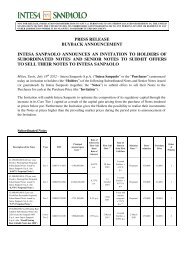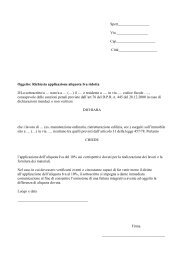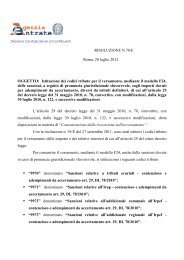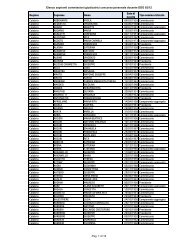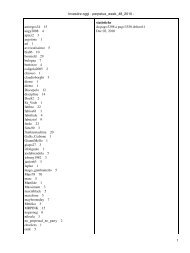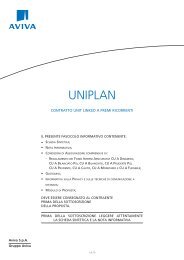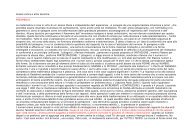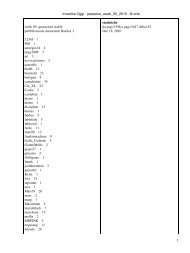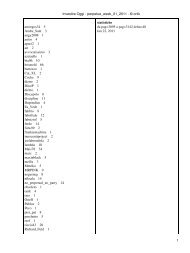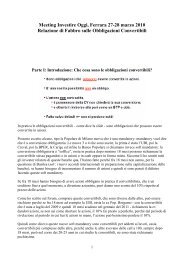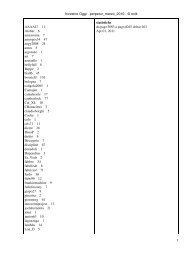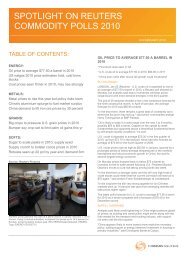Generali - InvestireOggi
Generali - InvestireOggi
Generali - InvestireOggi
Create successful ePaper yourself
Turn your PDF publications into a flip-book with our unique Google optimized e-Paper software.
Alan Bowe<br />
(44-20) 7134-1837<br />
alan.m.bowe@jpmorgan.com<br />
Table 3: ASSGEN: Solvency Ratios<br />
Q2 12<br />
Solvency I ratio 130%<br />
Economic Solvency* 151%<br />
Source: J.P. Morgan.* Group proxy for SII SCR<br />
Table 4: Historical: <strong>Generali</strong> Solvency I Ratio<br />
10<br />
Europe Credit Research<br />
11 October 2012<br />
Capital<br />
<strong>Generali</strong> reports a comparatively lower solvency I ratio than most other insurers and<br />
subsequently also trades at wider associated spreads. However, we note the Italian<br />
regulator applies caps and filters on off-balance sheet unrealized gains on real estate<br />
which can sometimes be substantial. For example in FY 2011 this would have been<br />
worth as much as 10ppts to the Solvency I ratio. Including these unrealized gains<br />
would allow <strong>Generali</strong>’s solvency ratio to be more comparable to that of its European<br />
peers 1 . Furthermore we note recent “anti crisis regulation” allows Italian insurance<br />
companies to limit the impact from falls in EU government bonds which if used<br />
would have provided a further 6ppts boost to <strong>Generali</strong>’s FY 2011 Solvency I ratio.<br />
Whilst this lighter touch approach from the regulator would be positive from the<br />
perspective of reducing the likelihood of regulatory intervention, we expect the<br />
market to discount both of these potential uplifts to solvency and thus would expect<br />
<strong>Generali</strong> to continue to seek alternative methods to improve its Solvency ratios over<br />
the medium term.<br />
% Q3 2009 Q4 2009 Q1 2010 Q2 2010 Q3 2010 Q4 2010 Q1 2011 Q2 2011 Q3 2011 Q4 2011 Q1 2012 Q2 2012<br />
Solvency I Ratio 132 128 129 140 150 132 140 134 137 117 133 130<br />
Source: Company reports. Excludes unrealised gains on real estate and "anti-crisis regulation" - including these ratio – E.g. FY 2011 would have been 134%<br />
As we highlight above, <strong>Generali</strong>'s Solvency ratio has been relatively volatile in<br />
recent periods due to its exposure to Italian Government bonds and translation<br />
through the AFS reserve. We expect this volatility to be reduced following actions<br />
taken by the ECB to stabilise the European Economy and as such the fluctuations in<br />
<strong>Generali</strong>’s AFS reserve should fall within a much narrower range. Thus it would<br />
appear to be less likely that <strong>Generali</strong> would need to utilise the “anti crisis regulation”<br />
in future periods.<br />
Figure 13: <strong>Generali</strong>: Solvency I Position<br />
25.00<br />
23.00<br />
21.00<br />
19.00<br />
17.00<br />
15.00<br />
22.30<br />
Source: Company reports.<br />
We highlight in Figure 15 that since August 2011, <strong>Generali</strong>’s risk has been<br />
influenced by Italian Government bond spreads substantially more than historically<br />
observed. We expect, whilst sovereign tensions remain high, that this is likely to<br />
continue; however, in our opinion as the sovereign risk premia decreases, the diverse<br />
nature of <strong>Generali</strong>’s business across Germany and CEE should offer additional<br />
1 Fitch, Sept 2012<br />
132%<br />
16.90<br />
20.80<br />
117%<br />
133% 130%<br />
23.80 23.50<br />
17.80 18.00 18.10<br />
FY 2010 FY 2011 Q1 2012 Q2 2012<br />
Available Margin Required Margin




